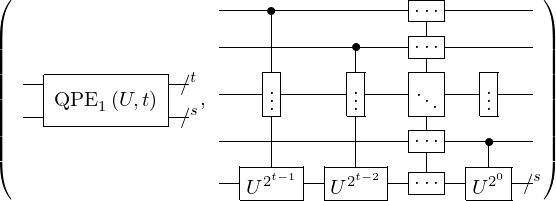
Expression of type Forall¶
from the theory of proveit.physics.quantum.QPE¶
In [1]:
import proveit
# Automation is not needed when building an expression:
proveit.defaults.automation = False # This will speed things up.
proveit.defaults.inline_pngs = False # Makes files smaller.
%load_expr # Load the stored expression as 'stored_expr'
# import Expression classes needed to build the expression
from proveit import ExprRange, U, Variable, VertExprArray, s, t
from proveit.linear_algebra import Unitary
from proveit.logic import Forall
from proveit.numbers import Add, Exp, Interval, NaturalPos, one, two
from proveit.physics.quantum.QPE import QPE1, QPE1_U_t_circuit
from proveit.physics.quantum.circuits import Gate, MultiQubitElem, Qcircuit, QcircuitEquiv
In [2]:
# build up the expression from sub-expressions
sub_expr1 = Variable("_a", latex_format = r"{_{-}a}")
sub_expr2 = Add(t, s)
sub_expr3 = MultiQubitElem(element = Gate(operation = QPE1(U, t), part = sub_expr1), targets = Interval(one, sub_expr2))
expr = Forall(instance_param_or_params = [s, t], instance_expr = Forall(instance_param_or_params = [U], instance_expr = QcircuitEquiv(Qcircuit(vert_expr_array = VertExprArray([ExprRange(sub_expr1, sub_expr3, one, t), ExprRange(sub_expr1, sub_expr3, Add(t, one), sub_expr2)])), QPE1_U_t_circuit), domain = Unitary(Exp(two, s))), domain = NaturalPos)
In [3]:
# check that the built expression is the same as the stored expression
assert expr == stored_expr
assert expr._style_id == stored_expr._style_id
print("Passed sanity check: expr matches stored_expr")
In [4]:
# Show the LaTeX representation of the expression for convenience if you need it.
print(stored_expr.latex())
In [5]:
stored_expr.style_options()
In [6]:
# display the expression information
stored_expr.expr_info()















































































































